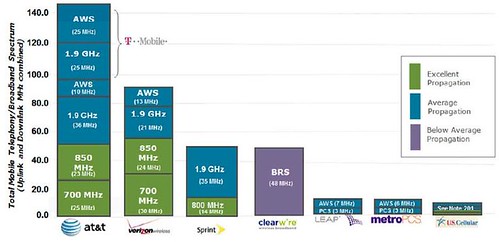AT&T Merger: Yea & Ney
Posted by Sam Churchill on June 7th, 2011 The FCC is asking six of AT&T’s top competitors to answer questions on network coverage, backhaul, pricing and spectrum for its review of AT&T’s $39 billion takeover of T-Mobile USA, reports Wireless Week.
The FCC is asking six of AT&T’s top competitors to answer questions on network coverage, backhaul, pricing and spectrum for its review of AT&T’s $39 billion takeover of T-Mobile USA, reports Wireless Week.The agency yesterday sent 37-page letters with a list of nine questions to Verizon Wireless, Sprint Nextel, U.S. Cellular, MetroPCS, Cellular South and Cricket Communications parent Leap Wireless, asking for detailed information about the companies’ operations. The operators have until June 20 to submit their answers to the FCC. The responses will be treated as confidential.
The documents suggest the FCC is interested in the merger’s effect on the wireless backhaul market, which is dominated by AT&T and Verizon Wireless.
In addition to questions about backhaul and spectrum, the FCC requested specific information on network coverage by technology type, such as GSM, EDGE, HSPA, HSPA+, CDMA and LTE, as well as plans for future network deployments. The agency also asked for information about prices, billing data and subscribers, as well as comments about how the operators view services offered by their competitors.
 Facebook, Yahoo, and Microsoft are supporting AT&T’s proposed merger with T-Mobile, saying the union could help meet a coming crunch for wireless broadband capacity.
Facebook, Yahoo, and Microsoft are supporting AT&T’s proposed merger with T-Mobile, saying the union could help meet a coming crunch for wireless broadband capacity.AT&T and T-Mobile can together “leverage a larger network of cell sites allowing greater reuse of spectrum and increasing the wireless broadband capacity of the network,”the companies wrote in a letter to the FCC. Several other companies signed on to the letter, including Avaya, Brocade, Oracle, Blackberry maker Research in Motion, and mobile chip maker Qualcomm.
The letter’s contents are a far cry from some of the negative testimony heard last month at a Senate hearing discussing the pros and cons of the merger.
Missing in action on the letter: Google and Apple.
Sprint pleads spectrum poverty in it’s filing with the FCC (below, pdf). The FCC includes only 55.5 MHz of BRS (low-power cellular) spectrum in its calculations due to other users sharing the band.
Sprint and Clearwire own some 150 Mhz in the 2.5-2.6 GHz band. But some 42 MHz of spectrum in the Middle Band Segment (“MBS”), between 2572-2614 MHz, is used primarily by Educational Broadcast stations (EBS) to transmit high-powered video for educational programming. Sprint says “low-power, cellularized operations in the Middle Band Segment could be subject to interference from legacy high-power video operations.” In addition, neither BRS Channel 1 (“BRS-1”) at 2496-2502 MHz nor the J and K Block guard bands at 2568-2572 MHz and 2614-2618 MHz are readily usable for mobile telephony/broadband services.
In a post by Forbes about Sprint’s 377-page document (pdf), Forbes notes the FCC has also been collecting comments from the public and has so far attracted more than 20,000 related to AT&T/T-Mobile. Most of the comments from individuals critique the deal while those from groups (industry associations, labor unions, etc.) are more positive.
The Department of Justice is working in parallel with the FCC to analyze the AT&T/T-Mobile deal.



No comments:
Post a Comment